| Oblique | |
|---|---|
| Hungarian: Ferde | |
 | |
| Artist | Victor Vasarely |
| Year | 1966 |
| Type | collage |
| Dimensions | 78 cm× 77 cm(31 in× 30 in) |
| Location | Museum of Fine Arts, Budapest |
Oblique (in Hungarian: Ferde) is a collage by Hungarian artist Victor Vasarely from 1966 to 1974.
| Oblique | |
|---|---|
| Hungarian: Ferde | |
 | |
| Artist | Victor Vasarely |
| Year | 1966 |
| Type | collage |
| Dimensions | 78 cm× 77 cm(31 in× 30 in) |
| Location | Museum of Fine Arts, Budapest |
Oblique (in Hungarian: Ferde) is a collage by Hungarian artist Victor Vasarely from 1966 to 1974.
Its dimensions are 78 x 77 centimeters. The picture is part of the collection of the Museum of Fine Arts in Budapest, Hungary. [1]
The Op art work is a grid of diagonal squares arranged to form a bright green central cross, whose colours fade and darken to black in successive rows away from it, overlaid with a pattern of uniformly dark blue roundels. Clipping of the shapes suggests overlapping layers, whose inferred edges interrupt the symmetry of the shapes with an elusive pattern. [2]
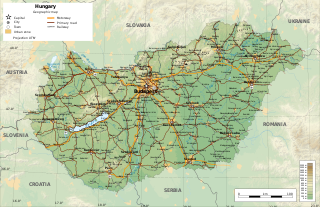
Hungary is a landlocked country in the southeastern region of Central Europe, bordering the Balkans. Situated in the Pannonian Basin, it has a land area of 93,030 square km, measuring about 250 km from north to south and 524 km from east to west. It has 2,106 km of boundaries, shared with Slovakia to the north, Ukraine to the northeast, Romania to the east and southeast, Serbia to the south, Croatia to the southwest, Slovenia to the west and southwest, and Austria to the west.

Buda was the historic capital of the Kingdom of Hungary and, since 1873, has been the western part of the Hungarian capital Budapest, on the west bank of the Danube. Buda comprises a third of Budapest's total territory and is mostly wooded. Landmarks include Buda Castle, the Citadella, and the president of Hungary's residence, Sándor Palace.
Romani is an Indo-Aryan macrolanguage of the Romani communities. According to Ethnologue, seven varieties of Romani are divergent enough to be considered languages of their own. The largest of these are Vlax Romani, Balkan Romani (600,000), and Sinte Romani (300,000). Some Romani communities speak mixed languages based on the surrounding language with retained Romani-derived vocabulary – these are known by linguists as Para-Romani varieties, rather than dialects of the Romani language itself.

A wallpaper is a mathematical object covering a whole Euclidean plane by repeating a motif indefinitely, in manner that certain isometries keep the drawing unchanged. For each wallpaper there corresponds a group of congruent transformations, with function composition as the group operation. Thus, a wallpaper group is a mathematical classification of a two‑dimensional repetitive pattern, based on the symmetries in the pattern. Such patterns occur frequently in architecture and decorative art, especially in textiles, tessellations, tiles and physical wallpaper.

The National Assembly is the parliament of Hungary. The unicameral body consists of 199 members elected to four-year terms. Election of members is done using a semi-proportional representation: a mixed-member majoritarian representation with partial compensation via transfer votes and mixed single vote; involving single-member districts and one list vote; parties must win at least 5% of the popular vote in order to gain list seats. The Assembly includes 25 standing committees to debate and report on introduced bills and to supervise the activities of the ministers. The Constitutional Court of Hungary has the right to challenge legislation on the grounds of constitutionality.
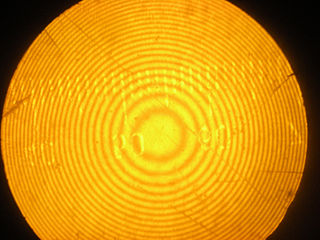
Newton's rings is a phenomenon in which an interference pattern is created by the reflection of light between two surfaces, typically a spherical surface and an adjacent touching flat surface. It is named after Isaac Newton, who investigated the effect in 1666. When viewed with monochromatic light, Newton's rings appear as a series of concentric, alternating bright and dark rings centered at the point of contact between the two surfaces. When viewed with white light, it forms a concentric ring pattern of rainbow colors because the different wavelengths of light interfere at different thicknesses of the air layer between the surfaces.
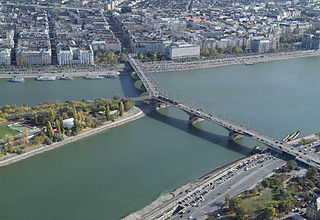
Margaret Bridge or Margit híd is a three-way bridge in Budapest, Hungary, connecting Buda and Pest across the Danube and linking Margaret Island to the banks. It is the second-northernmost and second-oldest public bridge in Budapest.
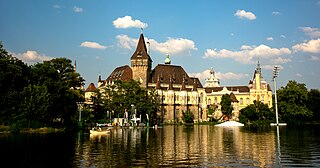
Vajdahunyad Castle is a castle in the City Park of Budapest, Hungary. It is a copy of Hunyad Castle, known as Corvin Castle, in Hunedoara, Romania. It was built in 1896 as part of the Millennial Exhibition which celebrated the 1,000 years of Hungary since the Hungarian Conquest of the Carpathian Basin in 895. The castle was designed by Ignác Alpár to feature copies of several landmark buildings from different parts of the Kingdom of Hungary, especially the Hunyad Castle in Transylvania. As the castle contains parts of buildings from various time periods, it displays different architectural styles: Romanesque, Gothic, Renaissance, and Baroque. Originally, it was made from cardboard and wood, but it became so popular that it was rebuilt from stone and brick between 1904 and 1908. Today, it houses the Museum of Hungarian Agriculture, the biggest agricultural museum in Europe.
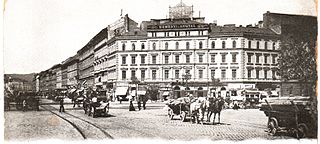
Oktogon is one of Pest's major intersections, located at the junction of the Grand Boulevard and Andrássy Avenue in Budapest, Hungary. This junction, one of the city's most important, is named for its octagonal shape.

The science of pattern formation deals with the visible, (statistically) orderly outcomes of self-organization and the common principles behind similar patterns in nature.

Hungarian Catholics, like elsewhere, are part of the worldwide Catholic Church under the spiritual leadership of the Pope in Rome.

In heraldry and heraldic vexillology, a blazon is a formal description of a coat of arms, flag or similar emblem, from which the reader can reconstruct the appropriate image. The verb to blazon means to create such a description. The visual depiction of a coat of arms or flag has traditionally had considerable latitude in design, but a verbal blazon specifies the essentially distinctive elements. A coat of arms or flag is therefore primarily defined not by a picture but rather by the wording of its blazon. Blazon is also the specialized language in which a blazon is written, and, as a verb, the act of writing such a description. Blazonry is the art, craft or practice of creating a blazon. The language employed in blazonry has its own vocabulary, grammar and syntax, which becomes essential for comprehension when blazoning a complex coat of arms.
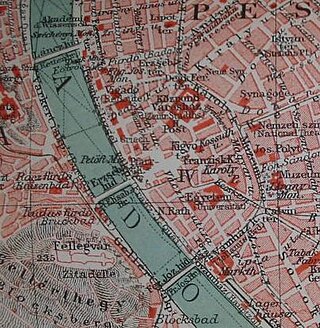
The Danube Promenade is located on the Pest side of Budapest, Hungary. The promenade itself lies on the left bank of the Danube, extending from the Széchenyi Chain Bridge to the Erzsébet Bridge.

The Royal Palace of Gödöllő or Grassalkovich Castle is an imperial and royal Hungarian palace located in the municipality of Gödöllő in Pest county, central Hungary. It is famous for being a favourite place of the Queen of Hungary.

Kempinski Hotel Corvinus, a member of the Kempinski group, is a five star hotel in Budapest, Hungary. Forbes gives it a four-star rating.
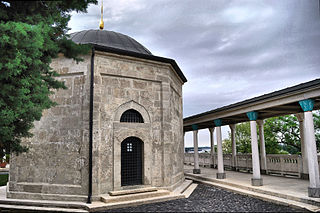
Gül Baba's tomb (türbe) in Budapest, Hungary, is the northernmost Islamic pilgrimage site in the world. The mausoleum is located in the district of Rózsadomb on Mecset (mosque) Street, a short but steep walk from Margaret Bridge.

The Danube Palace is a Neo-Baroque concert hall located in the Inner City of Budapest, Hungary. It was built between 1883 and 1885 according to the plans of Vilmos Freund. It was known as the casino of Lipótváros – not in the sense of gambling - but an aristocratic club for entertainment. The Palace served as a place of culture, supporting many young artists. Bartók, Kodály, and Dvorák all played in its first-class concert hall. Since 1951 the building has been carrying out the cultural programs of the Ministry of Internal Affairs. It is home to the Danube Symphony Orchestra.

The New Eve is a painting by Hungarian artist Sándor Bortnyik from 1924.

The Csokonai Theatre is the oldest and largest theatre in Debrecen, Hungary. It was named after one of the first Hungarian Modern Age playwrights, Mihály Csokonai, who lived and created many of his works in Debrecen. The building was designed by Antal Szkalnitzky with Moorish styled ornamentations, the theatre opened on Kossuth Lajos utca in 1865, with Róza Laborfalvi as Gertrude in a performance of József Katona's 1819 play Bánk bán.

Portrait of a Young Man Wearing Lynx Fur, Gentleman with a Lynx Pelt or Portrait of a Man is a 1560 painting by Paolo Veronese, produced during his stay in Rome and showing similarities to his Baptism of Christ and The Anointing of David. It is now in the Museum of Fine Arts in Budapest.
47°30′57″N19°04′36″E / 47.5159°N 19.0768°E